Men of fashion began to wear short and more natural hair at the end of the 18th century, sporting cropped curls and long sideburns in a classical manner much like Grecian warriors and Roman senators. Before this period, a balding Louis XIII had made powdered wigs popular at the French court and consequently throughout Europe. The often elaborate and expensive gray wigs lent an air of wisdom and authority to their wearers.
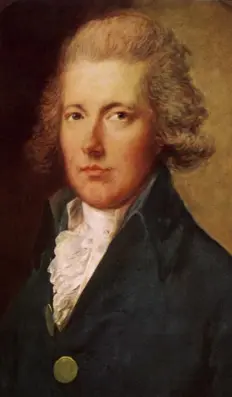
William Pitt the Younger – Attributed to Thomas Gainsborough (c. 1804)
Prime Minister 1783 – 1801; Chancellor of the Exchequer 1804 – 1806
A scarcity of flour in 1795, combined with William Pitt’s attempt to raise revenue through a hair powder tax, brought the fashion for wigs and powder to a screeching halt. Men protested and a new more natural hair style became fashionable.
The Bedford Crop was a style of hair favored by the Duke of Bedford, who, in protest to the tax, abandoned his wigs in favor of a short cropped and unpowdered hairstyle. He challenged his friends to do the same. His natural looking crop was parted on the side with a dab of hair wax.( Wikipedia)
Pitt eventually reduced this unpopular tax on hair powder, which never quite generated the revenue he predicted, but by then it was too late. Gentlemen had discovered the comforts of going au naturel, and by 1812, few men still wore wigs. There were some holdovers – older men, military officers, and those in conservative professions such as lawyers, judges, physicians, and some servants for the very rich (footmen and coachmen) retained their wigs and powder. Formal court dress also still required powdered hair.

Beau Brummel’s Brutus hair style in 1805. Notice how it is brushed forward and volumized on top of his head.
By and large men took their cue from classical Greek and Roman art. The romantic movement also influenced a natural, unpretentious aesthetic. A dry disordered look that used very few artificial products began to rule. Beau Brummel’s influence cannot be discounted. His own grooming included shorter hair and a clean-shaven face. Every morning he examined his face in a dentist mirror and plucked any remaining stray hairs with tweezers. By 1813, almost all Regency men sported both long or short sideburns; they rarely wore mustaches or beards.
In Pride and Prejudice 1995, Colin Firth as Mr. Darcy wore his hair somewhat longer than the Bedford Crop and affected a slightly unruly hairdo, probably known as the Brutus. (I confess I never liked Firth’s hairstyle for Mr. Darcy.)
Upon seeing the following images, I can now see why the film’s hair stylist settled on this slightly wild do for Mr. Darcy, which seems to be a compromise between a severe clipped hair style and the stylish “frightened owl” hairdo below.

Young man by an unknown artist, c. 1800, from the book The Tie. Image @Jessamyn’s Regency Costume Companion
The “frightened owl” hairstyle was achieved through infrequent hair washing (as infrequently as every few months) and the use of hair wax, which helped to create the wild and unruly volume.
Popular styles in the late 18th century were the Caesar, Titus, and Brutus. The Coup au Vent was short at the back and worn long over the eyes at the front.

Caesar cut. You can almost see the laurel leaves on his head with this brushed forward Caesar cut. Portrait of an unnamed man, ca. 1810-20
The Cherubin, like the Bedford Crop, sported short curls all over (the Caesar was clipped even closer.)

Bernier by Ingres, 1800. You can see the all over cropped unruly look. The sideburns in all these images are long, but the men are clean shaven.
The Classically influenced Titus was cropped short everywhere but at the front with curls combed forward onto the forehead to resemble the Roman Emperor Titus.

Balding men benefited from the close cropped, forward brushed styles. c.1815. Louis Francois Aubry. Monsieur Rivio Baritone in Paris Opera. Image courtesy of A Private Portrait Miniature Collection. (Update:) Mr. Phillips, who oversees the blog, lists the date of the portrait as 1840.
The more severe Brutus was even more clopped than the Titus. One of the most popular hair styles of the day, though, was the Brutus, a disheveled style that Beau Brummell and his followers wore.

John Opie’s 1802 portrait of Edmund Lenthal Swifte shows a few artfully arranged locks over the forehead.
These hairstyles took a great deal of time and patience to achieve. Men used an oil or pomade made of bear fat to achieve a natural “tamed” wildness. (Scented pomades were called Pomade de Nerole and Pomade de Graffa.) Since hair was rarely washed, night caps were worn to prevent soiling pillows and doilies protected the backs of chairs.

The height on top with the artfully arranged curls take precedence in this hairstyle. Friedrich Wilhelm Schelling, 1801.

Arnauld de Beaufort ca 1818 (by Pierre Paul pPrud’hon). His hair is noticeably brushed forward, lending his features a saturnine look.

Regency hairstyles gave men a natural, romanticized look. (Portrait of an Artist by Unknown Artist) is part of the collection of the Michele and Donald D’Amour Museum of Fine Arts, Springfield, Massachusetts.
Additional Information:
- A panoply of hairstyles sported by gentlemen
- Style Gallery Wikipedia
- Encyclopedia of Hair: A Cultural History By Victoria Sherrow, p 322-323
- Pomade Pot, Metropolitan Museum of Art
- French Fashions 1700-17890
Please note: All green links in this post are WordPress Ads.
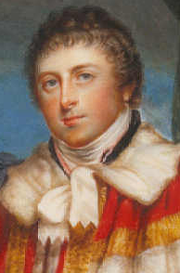
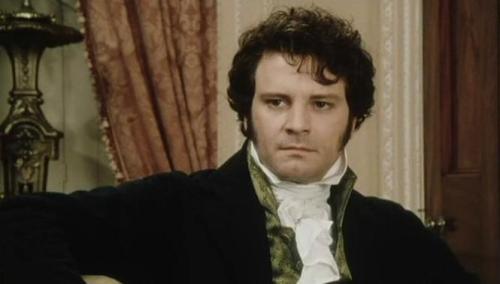
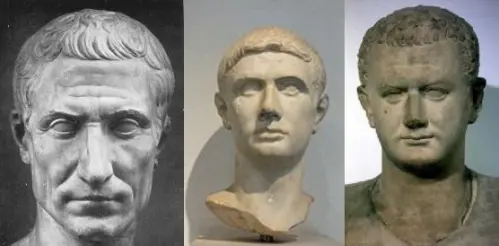
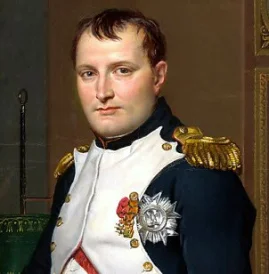

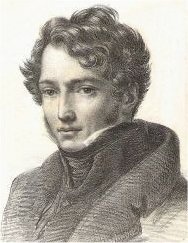
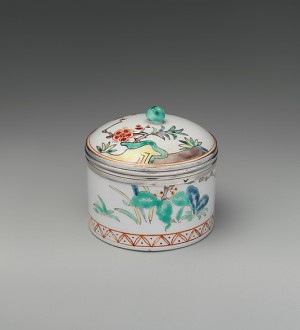








Vic,
This article is both amusing and informative. The gentlemen had some input from William Gell’s many books of amateur archeology of classical sites like Pompeii.
The question I’d like to ask is were these hairstyles of the ton, or did the general populace take on these styles as well i.e. the lower classes? I remember reading in Patrick O’Brian that those serving in the navy tended to hold on to the ‘older’ hairstyles (long hair held in a queue or braided). Was also curious to know if any feelings were expressed by men about long hair, if in its time of popularity it was considered a hallmark of masculinity, then later changed because of the desire to express an “upwardly mobile” intent? I ask this because I am developing a character who wears his hair in a long queue, but lives in the late Georgian era. I am trying to get a sense of why this character would choose to keep his hair long and why he would want to cut it short. I noted your remarks concerning the more conservative professions, but I guess Im curious to know if there would be an instance where someone would just choose a hair style out of sheer preference?
Thanks for letting me ramble…
I would look closely at the men’s hairstyles in my Pinterest board about Georgian occupations and at the dates. I think you will see a variety of hairstyles, some quite modern, that working men wear as well! http://pinterest.com/janeaustenworld/georgian-era-occupations/
i don’t know much obout england, but probably the fashion ended in the rest of Europe because of the influence of the french revolution. Supporters of the revolution rejected powder, wigs and long hair because they were used by the aristcracy and to imiteta roman republican heroes. Some supporters of the monarchy adopeted short hair to remember those who had their hair cut before being behaded. Only some men in the army (like some hussards that wore one or two braids) and the elderly kept their hair long. Take the portraits of Napoleon’s marshals and generals for example: only those thait at the end of the century were already in their 40es or more still have powdered or long hair. All the others had short hair with sideburns. (Well, Murat still favoured longer hair, but it is well known that he wanted appeared as dashing as possible, so probabaly he wanted to show off his beautiful dark curls.) it is also interesting to note that most of these officers came from middle and working class families. not to mention forget that thourgh the soldiers people across europe had the opportunity to see and copy french fashions.
Great article and illustrations, Vic. I think it’s interesting how older men still favoured the old styles, while the young took to new fashions. Jane Austen’s older brothers, Edward and James, wore their hair long, while Charles and Frank had short crops…
Reading about the bear fat takes some of the romance out of the era. I think I’ll ignore that particular fashion!
I love them. So much nicer than what we have now. Thanks for the post.
Reblogged this on Ella Quinn ~ Author and commented:
Another wonderful post from Jane Austen’s World.
Thanks for this information. It is very helpful
My grandmother dressed up her chair backs with doilies, and I always wondered where the custom originated… Dirty, greasy hair! Who would have guessed?! ;D
How do you have Colin Firth’s hair on P&P 1995? Anything posted here?
I have a beautiful hand-crocheted antimacassar on one of my chairs, strictly for decoration. Glad I don’t have visitors who oil their hair and leave it unwashed for months at a time! And I’m glad my husband would never be a “man of fashion,” no matter when he lived! Not sure how I would have preferred Colin’s Mr. Darcy’s hair, but the Brutus is at least not quite so awful as the Titus.
to sharon, it is my understanding that sailors often wore a long braid to pull them out of the water if they fell overboard. they often did not swim as they thought that would be not showing faith in their ship or some such nonsense. perhaps your character could have a sailing ”secret’ in his background
Oh well done, Vic!
Once again a brilliant post, but lets face it; that’s what we have come to expect from you Vic.
I must admit it gave me a smile yesterday afternoon, I was sitting in the garden enjoying a warm winters day (the temperature was a very pleasant 21° C – 70° F) and reading Emma for the eleventyninth time and came to chapter vii, Vol II; where Frank Churchill went up to Town for a haircut.
After having read this post I stopped and pondered; what style did he have it cut? And settled for the Schelling. ;-)
[…] “Men’s hair styles at the turn of the 19th century“ […]
Vic,
Love all the photos of different hairstyles. And isn’t it funny how history keeps recycling these things?
Suzi
I want to thank everyone for not noticing the disjointed sentences, which I have since fixed. I wrote this post a day after minor surgery and was warned about the effects of anesthesia, which I chose to ignore!!
Thank you all for visiting and leaving your comments.
I have a dandy’s haircut and, I shouldn’t divulge this, a dandy’s hygeine as well! (slightly modified, of course) I adopted the infrequent washing a few months ago and since doing so, my naturally curly hair has had no frizz! I haven’t tried bear-fat pomade yet: that is next on the list:) Thanks for the post, Vic.
A fascinating summary of male hairstyles. The infrequent washing of hair lends a whole new dimension to my appreciation of the regency – and not necessarily in a good way!
Grace x
I agree with Grace above, this has been a very interesting read. Thank you for sharing.
Another superb article. Interesting that the fashion for neo-classicism that affected painting, sculpture, interior design, architecture etc. post the excavations at Herculaneum and Pompeii should affect hair too. But then I guess the contrast between that and the Romantics’ looser hair is a precursor of the differences between hair trends in the 1950s and 1960s too.
Such a helpful and informative post! I too have a character with a penchant for long hair in 1811, though everyone around him is sporting the shorter do’s… His excuse is he’s American, and we all know how ‘barbarian’ they can be! Of course, the info on powdered hair in court dress is important… details, details… Off to browse your Pinterest page, thanks for the link!
Gainsborough died in 1788, making a portrait from him “c. 1804” a little unlikely.
John T: the portrait is by Gainsborough Dupont who was actually the nephew of Thomas Gainsborough. There’s a bit about it here: http://www.historicalportraits.com/Gallery.asp?Page=Item&ItemID=369&Desc=William-Pitt-PM-|-Gainsborough-Dupont